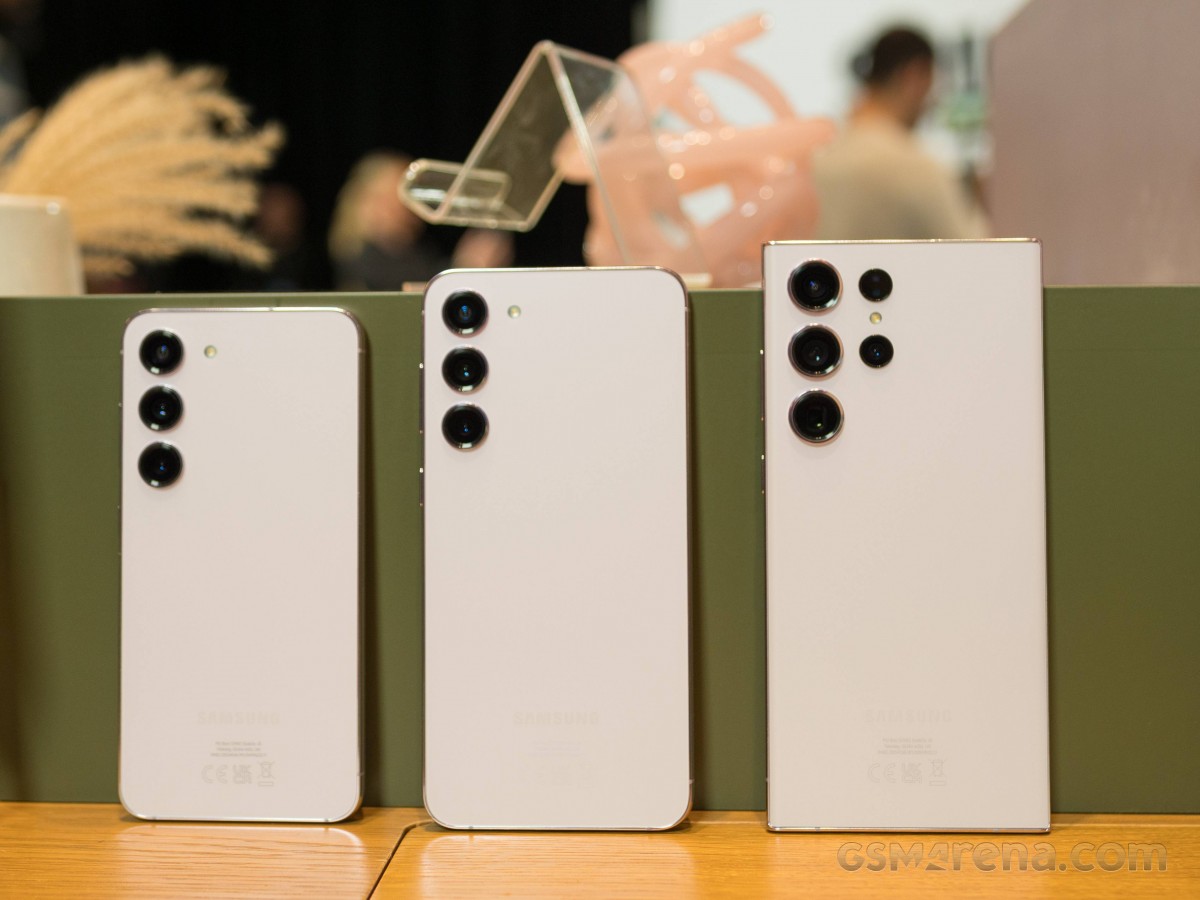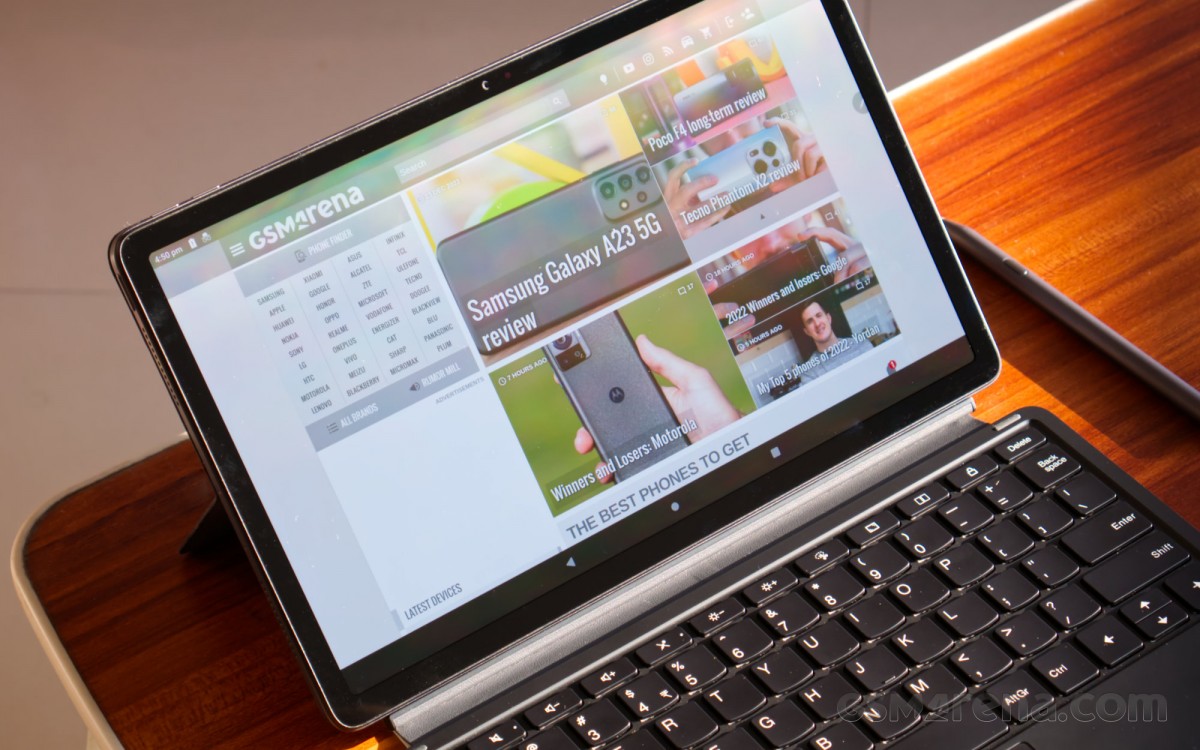Introduction
The Samsung Galaxy S23 Ultra is here alongside the Galaxy S23+ and Galaxy S23 and we can finally move past the leaks and rumors and into real and official territory. We've had some quality time with all three devices and would like to share some initial thoughts - how they feel, what's new, and what isn't.
Let's start with a few similarities to last year's models. For one, the formula hasn't changed. We're still getting an Ultra, a Plus, and vanilla, and their position, relative to the other, has also remained the same.
The Ultra is the no holds barred flagship phone, the Galaxy S23/S23+ are more affordable with a few "sensible" omissions. Size is also a factor - just like last year's models, the Ultra is the biggest in more ways than one - physically, screen-wise, and battery-wise.

As before, there are some key similarities between the three models. The biggest one is the underlying chipset - all three models use the Snapdragon 8 Gen 2, this one a custom-tuned version for these three devices specifically. Samsung and Qualcomm call it the Snapdragon 8 Gen 2 Mobile Platform for Galaxy, and it's basically a higher-clocked version of the familiar new chip.
The Ultra still has the upper hand in performance, thanks to the option of 12GB of RAM, while the S23/S23+ max out at 8GB.
The Galaxy S23 Ultra looks (and feels) familiar. You'd be excused for thinking it's a minimal upgrade over the Galaxy S22 Ultra. But you'd also be incorrect. If we agree that the camera, performance and battery life are the key areas where a phone can be upgraded, then the Galaxy S23 Ultra is a major upgrade over the Galaxy S22 Ultra.

The Snapdragon 8 Gen 2 brings moderate to big improvements to performance. Judging by some early benchmarks, the Cortex-X3 inside is 10% to 20% faster than the Cortex-X2 inside the Exynos 2200 in single-core tests. Multi-core scores for the new processor can be 30% to 60% better depending on the benchmark. The GPU is much faster as well. Samsung steered clear from naming percentages, but games like PUBG Mobile cap at around 60fps on the Exynos 2200-powered Galaxy S22 Ultra, while Snapdragon 8 Gen 2 devices supports gameplay at up to 120fps.
Synthetic scores aside, the new chip is much more efficient and less prone to thermal issues. Per specs alone, it's some 40% more efficient than its predecessor, which in itself was more efficient than the Exynos 2200, which was predominantly featured in the Galaxy S22 series globally. That means the Galaxy S23 Ultra will likely manage to squeeze more hours from its 5,000mAh battery pack - that's your major battery improvement done.
Finally, the new 200MP main camera could prove a generational upgrade over the old 108MP. The new sensor can output both 12MP and 50MP photos, depending on the scenario. And you can get those 50MP through the Expert RAW app, bringing prosumers a richer and sharper baseline. Night photography and video have also been improved.
Samsung Galaxy S23 Ultra specs at a glance:
- Body: 163.4x78.1x8.9mm, 233g; Glass front (Gorilla Glass Victus 2), glass back (Gorilla Glass Victus 2); IP68 dust/water resistant (up to 1.5m for 30 mins), Armor aluminum frame with tougher drop and scratch resistance (advertised), Stylus, 2.8ms latency (Bluetooth integration, accelerometer, gyro).
- Display: 6.80" Dynamic AMOLED 2X, 120Hz, HDR10+, 1750 nits (peak), 1440x3088px resolution, 19.3:9 aspect ratio, 501ppi; Always-on display.
- Chipset: Qualcomm SM8550-AC Snapdragon 8 Gen 2 (4 nm): Octa-core (1x3.36 GHz Cortex-X3 & 2x2.8 GHz Cortex-A715 & 2x2.8 GHz Cortex-A710 & 3x2.0 GHz Cortex-A510); Adreno 740.
- Memory: 256GB 8GB RAM, 256GB 12GB RAM, 512GB 12GB RAM, 1TB 12GB RAM; UFS 4.0.
- OS/Software: Android 13, One UI 5.1.
- Rear camera: Wide (main): 200 MP, f/1.7, 23mm, 1/1.3", 0.6µm, PDAF, Laser AF, OIS; Telephoto: 10 MP, f/2.4, 70mm, 1/3.52", 1.12µm, dual pixel PDAF, OIS, 3x optical zoom; Telephoto: 10 MP, f/4.9, 230mm, 1/3.52", 1.12µm, dual pixel PDAF, OIS, 10x optical zoom; Ultra wide angle: 12 MP, f/2.2, 13mm, 120˚, 1/2.55", 1.4µm, dual pixel PDAF.
- Front camera: 12 MP, f/2.2, 25mm (wide), PDAF.
- Video capture: Rear camera: 8K@24/30fps, 4K@30/60fps, 1080p@30/60/240fps, 720p@960fps, HDR10+, stereo sound rec., gyro-EIS; Front camera: 4K@30/60fps, 1080p@30fps.
- Battery: 5000mAh; 45W wired, PD3.0, 10W wireless (Qi/PMA), 4.5W reverse wireless.
- Misc: Fingerprint reader (under display, ultrasonic); NFC; stereo speakers; Samsung DeX, Samsung Wireless DeX (desktop experience support), Bixby natural language commands and dictation, Samsung Pay (Visa, MasterCard certified), Ultra Wideband (UWB) support.
In comparison to the Ultra, the Galaxy S23 and Galaxy S23+ are incremental updates. The biggest upgrade is the move to the Snapdragon 8 Gen 2, which will carry with it better general performance and battery endurance. The batteries have gotten a 200mAh bump on both models, making for a total of 3,900mAh and 4,700mAh on the S23 and S23+, respectively.
Samsung Galaxy S23+ specs at a glance:
- Body: 157.8x76.2x7.6mm, 195g; Glass front (Gorilla Glass Victus 2), glass back (Gorilla Glass Victus 2), aluminum frame; IP68 dust/water resistant (up to 1.5m for 30 mins), Armor aluminum frame with tougher drop and scratch resistance (advertised).
- Display: 6.60" Dynamic AMOLED 2X, 120Hz, HDR10+, 1080x2340px resolution, 19.5:9 aspect ratio, 390ppi; Always-on display.
- Chipset: Qualcomm SM8550 Snapdragon 8 Gen 2 (4 nm): Octa-core (1x3.36 GHz Cortex-X3 & 2x2.8 GHz Cortex-A715 & 2x2.8 GHz Cortex-A710 & 3x2.0 GHz Cortex-A510); Adreno 740.
- Memory: 256GB 8GB RAM, 512GB 8GB RAM; UFS 4.0.
- OS/Software: Android 13, One UI 5.1.
- Rear camera: Wide (main): 50 MP, f/1.8, 23mm, 1/1.56", 1.0µm, Dual Pixel PDAF, OIS; Telephoto: 10 MP, f/2.4, 70mm, 1/3.94", 1.0µm, PDAF, 3x optical zoom; Ultra wide angle: 12 MP, f/2.2, 13mm, 120˚, 1/2.55" 1.4µm, Super Steady video.
- Front camera: 12 MP, f/2.2, 25mm (wide), PDAF.
- Video capture: Rear camera: 8K@24/30fps, 4K@30/60fps, 1080p@30/60/240fps, 720p@960fps, HDR10+, stereo sound rec., gyro-EIS; Front camera: 4K@30/60fps, 1080p@30fps.
- Battery: 4700mAh; 45W wired, PD3.0, 10W wireless (Qi/PMA), 4.5W reverse wireless.
- Misc: Fingerprint reader (under display, ultrasonic); NFC; stereo speakers; Samsung DeX, Samsung Wireless DeX (desktop experience support), Bixby natural language commands and dictation, Samsung Pay (Visa, MasterCard certified).
Samsung Galaxy S23 specs at a glance:
- Body: 146.3x70.9x7.6mm, 167g; Glass front (Gorilla Glass Victus 2), glass back (Gorilla Glass Victus 2), aluminum frame; IP68 dust/water resistant (up to 1.5m for 30 mins), Armor aluminum frame with tougher drop and scratch resistance (advertised).
- Display: 6.10" Dynamic AMOLED 2X, 120Hz, HDR10+, 1080x2340px resolution, 19.5:9 aspect ratio, 422ppi; Always-on display.
- Chipset: Qualcomm SM8550 Snapdragon 8 Gen 2 (4 nm): Octa-core (1x3.36 GHz Cortex-X3 & 2x2.8 GHz Cortex-A715 & 2x2.8 GHz Cortex-A710 & 3x2.0 GHz Cortex-A510); Adreno 740.
- Memory: 128GB 8GB RAM, 256GB 8GB RAM; UFS.
- OS/Software: Android 13, One UI 5.1.
- Rear camera: Wide (main): 50 MP, f/1.8, 23mm, 1/1.56", 1.0µm, Dual Pixel PDAF, OIS; Telephoto: 10 MP, f/2.4, 70mm, 1/3.94", 1.0µm, PDAF, 3x optical zoom; Ultra wide angle: 12 MP, f/2.2, 13mm, 120˚, 1/2.55" 1.4µm, Super Steady video.
- Front camera: 12 MP, f/2.2, 25mm (wide), PDAF.
- Video capture: Rear camera: 8K@24/30fps, 4K@30/60fps, 1080p@30/60/240fps, 720p@960fps, HDR10+, stereo sound rec., gyro-EIS; Front camera: 4K@30/60fps, 1080p@30fps.
- Battery: 3900mAh; 25W wired, PD3.0, 10W wireless (Qi/PMA), 4.5W reverse wireless.
- Misc: Fingerprint reader (under display, ultrasonic); NFC; stereo speakers; Samsung DeX, Samsung Wireless DeX (desktop experience support), Bixby natural language commands and dictation, Samsung Pay (Visa, MasterCard certified).
The rest of the Galaxy S23/S23+ specs read similarly to their predecessors. You get a mostly unchanged triple camera setup - wide, 3x, and ultrawide on the rear, and a 12MP selfie on the front, that's shared between all three models.
The 6.1-inch and 6.6-inch 1080x2340px Dynamic AMOLED 2X 120Hz displays are also straight out of last year's Galaxy S22 and S22+.
Samsung made the decision to remove the contoured camera island on the Galaxy S23 and S23+. It brings the pair in line with the flatter, more minimalist look of the Galaxy S23 Ultra. Samsung calls it a linear design across all models. Some might call it overly simple, even boring.
All three models come in four colors - Phantom Black, Cream, Green, and Lavender. All three are also covered in the new Gorilla Glass Victus 2 - these are the first devices to use the material.

That's it for the general outline of the new Galaxy S23 series. It paints a picture similar to 2022 - the Galaxy S23 and Galaxy S23+ aren't compelling upgrades for owners of the previous generation, while the Ultra model can be, depending on your needs. There's no addition as big as last year's inclusion of an S Pen, but sometimes refinement is just as important as innovation.
We'll look at the hardware in detail in the next couple of pages.








